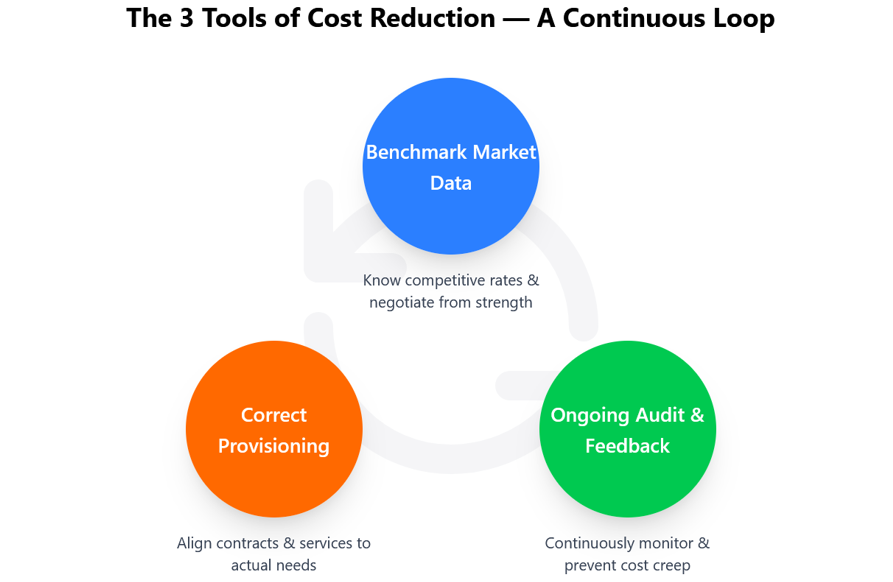Building a Simple Continuous Improvement System for Wood River Valley Businesses

Running a business in the Wood River Valley is deeply rewarding — but it often comes with rising operating costs, seasonal rhythms, limited staffing, and the constant challenge of managing vendors, subscriptions, and service contracts.
In my work representing Schooley Mitchell of Idaho, helping local organizations review telecom, software, merchant services, waste contracts, freight, and other recurring expenses, I see a consistent pattern:
Most businesses are paying more than they need to — often by 10–30% — without realizing it.
Not because anyone is careless, but because small fees, outdated plans, and automatic renewals slip by unnoticed.
The good news is that a simple Continuous Improvement System (CIS) can give businesses clearer control over their spending without adding complexity or workload. It’s a structure I use with Schooley Mitchell clients across Idaho, and it works for organizations of every size and industry.
Here’s how any local business can start.
1. Gather all recurring costs in one place
Telecom, internet, software subscriptions, merchant services, shipping, waste, and utilities are often scattered across people and departments.
In nearly every Schooley Mitchell engagement I’ve done locally, simply compiling this list reveals hidden charges or outdated services.
2. Review these costs once every quarter
A 90-day rhythm keeps costs from drifting.
During each review:
- Check for new fees
- Compare usage to what you’re paying for
- Confirm pricing is still competitive
- Flag contracts that are set to auto-renew
This is the same cadence Schooley Mitchell uses when monitoring client accounts — it prevents surprises and keeps spending aligned with current needs.
3. Assign an owner for each category
Even small teams can benefit from clear responsibility.
One person watching subscriptions, another watching telecom, someone else watching waste or merchant services.
When nobody is assigned, costs drift.
When someone is assigned, even lightly, waste drops fast.
4. Keep a one-page dashboard
A CIS doesn’t require software.
A simple dashboard works:
- Vendors
- Costs
- Renewal dates
- Notes
- Owner
- Status
It’s the same type of dashboard I maintain for Schooley Mitchell clients — clean, simple, and actionable.
5. Focus on the categories where drift is most common
Across the Valley, I consistently find overspending in:
- Telecom & internet (old plans, outdated pricing)
- Software & subscriptions (unused seats, duplicate tools)
- Credit card processing (quiet fee changes)
- Waste & recycling (misaligned service levels)
- Shipping & delivery (paying for unnecessary speed or surcharges)
These are Schooley Mitchell’s core specialty areas — and also where local businesses tend to see the fastest improvements.
6. Reinvest savings into what matters most
A healthy CIS isn’t about cutting — it’s about redirecting resources where they make a real difference:
- Staff development and retention
- Technology upgrades
- Improving customer experience
- Seasonal staffing
- Expanding nonprofit programs
- Facility repairs or modernization
When organizations free up dollars they’ve been overspending on vendor services, that money stays in the Valley — supporting jobs, stability, and community vitality.
Why this matters for the Wood River Valley
A stronger, more efficient local business community benefits all of us:
- More stable jobs
- Healthier nonprofits
- Better customer experiences
- Stronger local hiring
- A more resilient economy
Every dollar saved from unnecessary vendor waste is a dollar that stays right here in our Valley.
Complimentary Savings & Improvement Snapshot
As the local Schooley Mitchell consultant serving the Wood River Valley, I offer a complimentary Savings & Improvement Snapshot to help organizations identify where costs may be drifting.
This includes:
- A quick review of your recurring vendor expenses
- Insight into whether your pricing is competitive
- Identification of hidden fees or outdated services
- Simple steps to implement your own Continuous Improvement System
- Optional ongoing monitoring if you want a partner to manage it
This service is free, fast, and designed to support our local business community.
If you’d like to set up a snapshot or ask questions, I’d be happy to help.
John Rumasuglia works with Schooley Mitchell to help Idaho businesses improve margins and free up resources for growth. From Hailey, he supports manufacturers, nonprofits, and service providers across the Wood River Valley. More information is available at www.schooleymitchell.com/jrumasuglia

